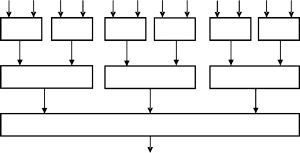Class of minimax error-corecting codes based on perfect binary arrays
DOI:
https://doi.org/10.3103/S0735272711090032Keywords:
perfect binary array, synthesis method, complementary matrix, error-correcting code, coding algorithm, decoding algorithm, maximum likelihoodAbstract
Developed the regular synthesis method of infinite family of minimax M(N)-classes of perfect binary arrays of order N = 2k, where k — arbitrary integer. On this basis, a new class of four-parameter minimax correcting M(n)-codes of length n = N2, which have many practically attractive properties, were constructed. The task of decoding is reduced to an effective procedure of majority estimation of parameters of received code words.
References
- M. I. Mazurkov and V. Ya. Chechelnytskyi, “The Classes of Equivalent and Generative Perfect Binary Arrays for CDMA-Technologies,” Izv. Vyssh. Uchebn. Zaved., Radioelektron. 46(5), 54 (2003); Radioelectron. Commun. Syst. 46(5), 50 (2003).
- M. I. Mazurkov, V. Ya. Chechelnytskyi, and M. Yu. Gerasimenko, “Classes of Minimax Bi-Phase Signals Based on Perfect Binary Arrays,” Izv. Vyssh. Uchebn. Zaved., Radioelektron. 49(10), 25 (2006); Radioelectron. Commun. Syst. 49(10), 16 (2006).
- J. Jedwab and C. Mitchell, “Constructing new perfect binary arrays,” Electron. Lett. 24, 650 (1988).
- P. Wild, “Infinite Families of Perfect Binary Arrays,” Electron. Lett. 24, No. 14, 845 (1988).
- L. E. Kopilovich, “On Perfect Binary Arrays,” Electron. Lett. 24, No. 8, 566 (1988).
- I. A. Gepko, “Synthesis of Perfect Binary Arrays,” Izv. Vyssh. Uchebn. Zaved., Radioelektron. 41(6), 13 (1998); Radioelectron. Commun. Syst. 41(6), 10 (1998).
- I. A. Gepko, “Perfect Time-Frequency Codes for Multifrequency CDMA Technologies,” Izv. Vyssh. Uchebn. Zaved., Radioelektron. 43(2), 66 (2000); Radioelectron. Commun. Syst. 43(2), 53 (2000).
- M. I. Mazurkov and M. Yu. Gerasimenko, “Fast Orthogonal Transforms Based on Perfect Binary Arrays,” Izv. Vyssh. Uchebn. Zaved., Radioelektron. 49(9), 54 (2006); Radioelectron. Commun. Syst. 49(9), 36 (2006).
- P. E. Baranov, M. I. Mazurkov, V. Ya. Chechelnytskyi, and A. A. Yakovenko, “Family of Two-Dimensional Correcting Codes on a Basis of Perfect Binary Array,” Izv. Vyssh. Uchebn. Zaved., Radioelektron. 52(9), 65 (2009) [Radioelectron. Commun. Syst. 52(9), 501 (2009)].
- M. I. Mazurkov, V. Ya. Chechel’nitskii and P. Murr, “Information security method based on perfect binary arrays,” Izv. Vyssh. Uchebn. Zaved., Radioelektron. 51(11), 53 (2008) [Radioelectron. Commun. Syst. 51(11), 612 (2008)].
- M. I. Mazurkov, V. Ya. Chechelnytskyi, and K. K. Nekrasov, “Three-Level Cryptographic System for Block Data Encryption,” Izv. Vyssh. Uchebn. Zaved., Radioelektron. 53(7), 43 (2010) [Radioelectron. Commun. Syst. 53(7), 376 (2010)].
- L. E. Varakin, Communications Systems with Noise-Like Signals (Radio i Svyaz’, Moscow, 1985) [in Russian].
- A. M. Trakhtman and V. A. Trakhtman, Rudiments of the Theory of Discrete Signals on Finite Intervals (Sov. Radio, Moscow, 1975) [in Russian].
- G. C. Clark, Jr. and J. B. Cain, Error Correction Coding for Digital Communications (Plenum Press, New York, 1981; Radio i Svyaz’, Moscow, 1987).
- I. M. Vinogradov, Rudiments of the Theory of Numbers (Nauka; GRFML, Moscow, 1981) [in Russian].
- R. E. Blahut, Theory and Practice of Error Control Codes (Addison-Wesley Publishing Company Inc., Massachusetts, 1983; Mir, Moscow, 1986).

Downloads
Published
2011-09-01
Issue
Section
Research Articles

